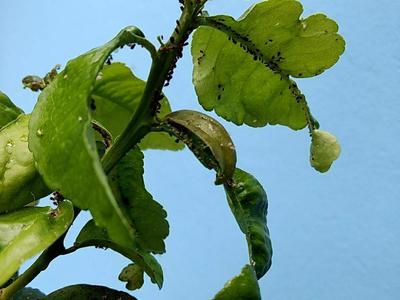Black Citrus Aphid
Toxoptera aurantii
Insect
In a Nutshell
- Distorted twigs and leaves.
- Wilting and yellowing of leaves.
- Honeydew promotes colonization by sooty mold.
- Downgraded fruit quality.
- Brownish to black body with or without wings.
Can also be found in
Symptoms
All growth stages of citrus trees can be affected. The aphids have long piercing mouth-parts which they use to suck the sap on shoot tips and young leaves, leading to distortions of twigs and the curling, rolling or folding of leaves. As they feed on the sweet plant phloem, they excrete the excess sugar as honeydew. When it falls onto leaves, it is readily colonized by sooty mold fungi that make the leaves turn black. This limits photosynthesis and has consequences on the vigor of the tree and the quality of the fruits. The damage to citrus trees can also be due to the infection of the tristeza virus, which is carried by the aphids.
Recommendations

Organic Control
Predators include many species of hoverflies, lacewings and ladybirds that can attack aphids at all stages of development. Two commonly used coccinellids against this pest are adults and larvae of Cycloneda sanguinea and Hippodamia convergens. Some culture-specific parasitic wasps may also be available for citrus in the area of interest. The fungus Neozygites fresensii can be an important check on aphid populations during humid weather. Ants can be killed with boiling water or with solutions containing natural pyrethrins. Insecticidal solutions can also be used against aphids, for example solutions based on soap, detergent soap, neem or chilli extracts.

Chemical Control
Always consider an integrated approach with preventive measures together with biological treatments if available. Several insecticides can be used to control aphids but their effectiveness depends on a timely application, for example before the leaves curl or populations become too large. Commercial products containing petroleum oil can be sprayed on the underside of leaves, so that they directly contact the aphids. Synthetic pyrethroids are also likely to be effective against aphids and ants, but can also have a negative impact on natural enemies.
What caused it?
Symptoms are caused by the adults and nymphs of the black citrus aphid Toxoptera aurantii. They often co-infect citrus trees and other cultures together with another related species of aphid T. citricida, commonly known as brown citrus aphid. Adults exist in two forms, either with or without wings. Winged specimens can fly distances of up to 30 km and are found when they become too numerous or when food supply is limited. They have a dull brownish to black body with a length of about 1.5 mm. The black citrus aphid has a simple life cycle and a high reproduction rate that can lead to rapid and severe infestations. The temperature range for development, survival and reproduction varies between 9.4 and 30.4 °C. The honeydew attracts ants, which in turn protect the aphids from natural predators. They are considered a vector of the tristeza disease of citrus and the zucchini yellow mosaic virus.
Preventive Measures
- Choose seeds from healthy plants or from certified sources.
- If possible, plant in an area free of this pest, and isolated geographically.
- Monitor fields regularly to assess the incidence of a disease or pest and determine their severity.
- Hand-pick the aphids manually from the plant or remove infected plant parts.
- Check for weeds in and around the fields.
- Do not over-water or over-fertilize.
- Control ant populations that protect aphids with sticky bands or nets.
- Do not transport citrus trees between different farms or areas.
- Control the use of pesticides, as those can affect negatively the populations of beneficial insects.
- Prune the branches of your trees or remove the bottom leaves of your plants to favor the ventilation of the canopy.



